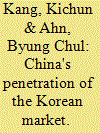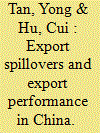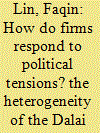|
|
|
Sort Order |
|
|
|
Items / Page
|
|
|
|
|
|
|
| Srl | Item |
| 1 |
ID:
099161


|
|
|
|
|
| Publication |
2010.
|
| Summary/Abstract |
China's penetration of the world market has been impressive. This paper uses highly disaggregated Korean import data (from 1992 to 2008) to examine China's penetration of the Korean market in the context of the composition of value (the extensive and intensive margins) and the product type (homogeneous and differentiated) in trade. The increase in Chinese imports has been attributed to the rapid increase in the import of new products (the extensive margin) and of existing products (the intensive margin). However, the growth rate of new products decelerated in the 2000s. The growth in the intensive margin was due to quantity, not price. Chinese imports to Korea did not improve over the period in terms of quality. Although Chinese products became cheaper, they were more differentiated over time. Welfare gains were realized through the expanded introduction of new products from China. However, much of the gains from Korea's Chinese product import boom were realized in earlier years (1992-2000) because even though imported products became more differentiated, the increase in the extensive margin was lower in more recent years (2001-2008).
|
|
|
|
|
|
|
|
|
|
|
|
|
|
|
|
| 2 |
ID:
133183


|
|
|
|
|
| Publication |
2014.
|
| Summary/Abstract |
This paper decomposes the growth of China's export into three parts: growth in extensive margin, increased quantity and increased prices; we perform a series of empirical analyses using China's export data at the HS-6 digit level to analyze the characteristics of China's export growth. China's export growth depends more and more on price increases, less and less on quantity expansion. Compared with the rest of world, China's export price is in the process of improving, not at an increasing speed but at a declining pace. China's export performance is better than the rest of the world after the financial crisis and in 2008-2010. This reflects a strategy of lowering price and promoting sales in 2009 when facing a slump in export markets; and resuming price increases and increasing sales moderately in reaction to improving export conditions in 2010.
|
|
|
|
|
|
|
|
|
|
|
|
|
|
|
|
| 3 |
ID:
162631


|
|
|
|
|
| Summary/Abstract |
Based on data from the Chinese Industrial Enterprises Database, this paper investigates the effect of “Internet Plus” on the trade destination mix at the enterprise level. The analysis extends the classic dual margins to three dimensions: destination extensive, destination intensive and destination structural margins. The paper suggests that connecting to the internet not only raises Chinese firms' propensity to export, but also extends the destination extensive margin. In addition, Internet Plus could create a synergistic effect for internet‐enabled enterprises, that is, the development of the destination country's internet access benefits domestic firms' export participation. Finally, the paper finds that Internet Plus, rather than increasing the intensive or structural margins, leads to the transfer of exports to lower‐middle‐income countries and helps firms achieve competitiveness and thus increases their profit. The paper provides an explanatory mechanism and empirical evidence for firms' use of the internet to optimize export space.
|
|
|
|
|
|
|
|
|
|
|
|
|
|
|
|
| 4 |
ID:
149762


|
|
|
|
|
| Summary/Abstract |
This paper examines the local export spillover effect on the individual decisions to start exporting (the extensive margin) and export volume (the intensive margin), using a unique dataset of Chinese export firms, at the product-level and by destination country. Based on a gravity-type equation estimated at firm-level, we find that export spillovers positively influence not only the decision of a nearby firm to start exporting, but also the volume of the exporting. Several methods are used to verify the robustness of these results. In addition, we find that the effect of export spillovers is stronger when it is product-destination-specific than that when it is either product or destination-specific alone, and also stronger than that is in general. Geographically, local export spillovers exhibit spatial decay in China: the effect is stronger for firms located in the same city than it is for firms outside the city. Small and multi-product firms are more likely to be influenced by the local export spillovers, and their impact is stronger for firms exporting complex goods and exporting to easy-entry countries. Moreover, the export spillovers from private firms are the strongest, followed by foreign-invested firms with the effect generated by state-owned firms ranking last.
|
|
|
|
|
|
|
|
|
|
|
|
|
|
|
|
| 5 |
ID:
103934


|
|
|
|
|
| Publication |
2011.
|
| Summary/Abstract |
We developed a methodology to decompose export growth into three margins: extensive margin, price and quantity. We then decomposed data on China's export trade with 140 partners in 2001 and 2007 into the three margins. We arrive at the following conclusions: China's export growth is mainly driven by quantity growth, which accounts for about 70% of overall export growth. This conclusion is robust for different partners, different industries and different techniques. To convert export quantity-driven growth into extensively margin- and quality-driven growth is a major challenge for the Chinese government and China's enterprises in the long term.
|
|
|
|
|
|
|
|
|
|
|
|
|
|
|
|
| 6 |
ID:
180631


|
|
|
|
|
| Summary/Abstract |
After the formation of the World Trade Organization (WTO) in 1995, most countries gradually reduced their import tariffs to a fairly low level. However, the reduced tariffs could not be simply read as a reduction in trade barriers. Indeed, many suspect that countries tend to use more non-tariff measures (NTMs), substituting them for tariff barriers, to protect their domestic economies. This paper uses newly compiled and detailed Chinese NTM data, together with highly disaggregated firm import data and manufacturing firm operational data, to investigate the impact of China's import-related NTMs on firm imports. The main empirical results show that, as in the case of tariff barriers, China's trade policy NTMs mainly inhibit firms’ intermediate imports. In contrast, China's public policy NTMs significantly improve the intensive and extensive margins of firm's intermediate imports and raise the prices and quality of imported inputs. The greater the extent to which a firm engages in processing trade, the larger is the promoting effect of public policy NTMs on the firm's import margins for intermediate inputs, and the greater is the restricting effect on the prices and the quality of the firm's imported inputs.
|
|
|
|
|
|
|
|
|
|
|
|
|
|
|
|
| 7 |
ID:
170088


|
|
|
|
|
| Summary/Abstract |
Little is known about the firm-level dynamics behind trade responses to political tensions. This article reinvestigates variation in the travel pattern of the 14th Dalai Lama to study how political tensions affect trading decisions of Chinese importers. Using monthly trade data from China Customs covering imports of machinery and transport equipment from 173 countries over the 2000–2006 period, our empirical results show a significant reduction of imports in response to foreign government members' meetings with the Dalai Lama. In line with the idea that Chinese importers face a trade-off between bearing costs from suboptimal trade transactions and costs from not accommodating the government, this ‘Dalai Lama Effect’ operates at the intensive margin, i.e., via a decrease in the import volume per importer. Examining differential effects across types of firm ownership, we find that the observed effect is driven by state-owned enterprises (and foreign-invested firms) and not by private companies. Moreover, while direct importers temporarily reduce their trade with Dalai Lama-receiving countries, there is some evidence that trade intermediaries fill the void. Overall, we find the effects to be much more short-lived than previously thought.
|
|
|
|
|
|
|
|
|
|
|
|
|
|
|
|
|
|
|
|
|